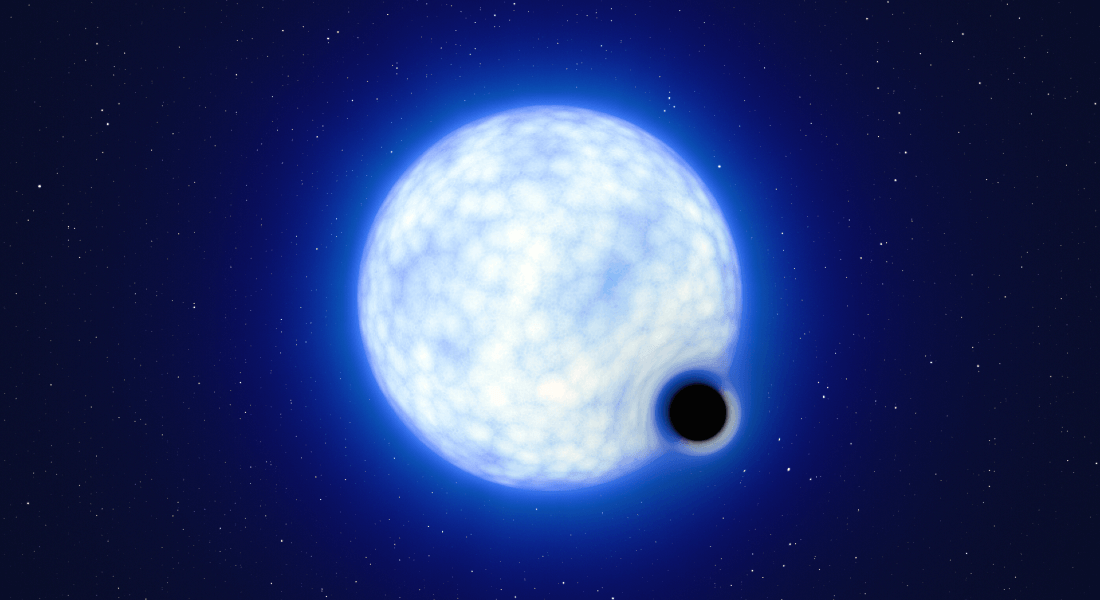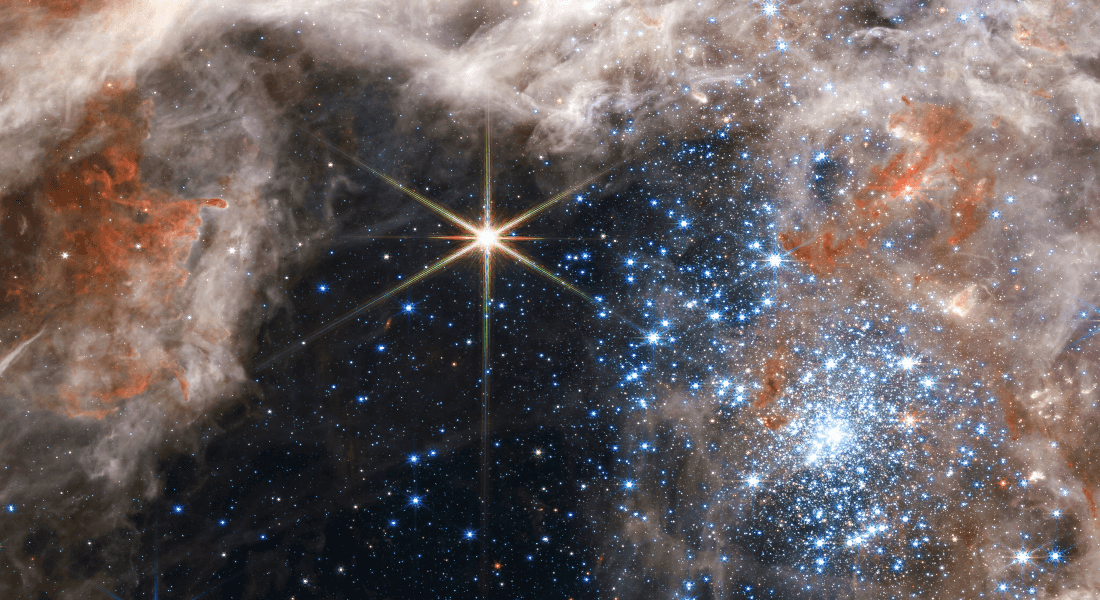Complete Stellar Collapse: unusual star system proves that stars can die quietly
University of Copenhagen astrophysicists help explain a mysterious phenomenon, whereby stars suddenly vanish from the night sky. Their study of an unusual binary star system has resulted in convincing evidence that massive stars can completely collapse and become black holes without a supernova explosion.

One day, the star at the center of our own solar system, the Sun, will begin to expand until it engulfs Earth. It will then become increasingly unstable until it eventually contracts into a small and dense object known as a white dwarf.
However, if the Sun were of a weight class roughly eight times greater or more, it would probably go out with a huge bang – as a supernova. Its collapse would culminate into an explosion, ejecting energy and mass into space with enormous force, prior to leaving behind a neutron star or a black hole in its wake.
While this is basic knowledge about how massive stars die, there remains plenty to understand about the starry skies above and the spectacular death of these stars in particular.
New research by astrophysicists at the University of Copenhagen’s Niels Bohr Institute presents the strongest evidence to date that very massive stars can succumb with far more stealth and discretion than as supernovae. Indeed, their investigation suggests that, with enough mass, a star’s gravitational pull can be so strong that no explosion takes place upon its death. Instead, the star can go through what is known as a complete collapse.
Facts and myths: Disappearing stars
In modern times, there have been many observations of stars that inexplicably disappear.
“A Survey about Nothing” led by astrophysicist Chris Kochanek is an example of the research efforts actively looking for disappearing stars and explanations for their disappearance.
The curious reader can also delve into historical descriptions. These often have to do with suddenly luminous stars that disappear consistent with supernova scenarios. But there are other stories about suddenly disappearing stars, such as the Greek myth associated with the Pleiades star cluster, commonly known as the Seven Sisters. The Pleiades myth describes the seven daughters of the titan Atlas and nymph Pleione. According to the myth, one of their daughters married a human and went into hiding, which provides a very unscientific, but beautiful explanation for why we only see six stars in the Pleiades.
"We believe that the core of a star can collapse under its own weight, as happens to massive stars in the final phase of their lives. But instead of the contraction culminating into a bright supernova explosion that would outshine its own galaxy, expected for stars more than eight times as massive as the Sun, the collapse continues until the star becomes a black hole," explains first author Alejandro Vigna-Gómez, who was a postdoc at the Niels Bohr Institute when this study set in motion.
This discovery is linked to the phenomenon of disappearing stars, which has interested astronomers in recent years, and it may provide both a clear-cut example as well as a plausible scientific explanation for phenomena of this kind.
"Were one to stand gazing up at a visible star going through a total collapse, it might, just at the right time, be like watching a star suddenly extinguish and disappear from the heavens. The collapse is so complete that no explosion occurs, nothing escapes and one wouldn't see any bright supernova in the night sky. Astronomers have actually observed the sudden disappearance of brightly shining stars in recent times. We cannot be sure of a connection, but the results we have obtained from analysing VFTS 243 has brought us much closer to a credible explanation," says Alejandro Vigna-Gómez.
An unusual star system with no signs of an explosion
This discovery has been prompted by the recent observation of an unusual binary star system at the edge of our galaxy called VFTS 243. Here, a large star and black hole roughly 10 times more massive than our Sun orbit one another.
Scientists have known about the existence of such binary star systems in the Milky Way for decades, where one of the stars has become a black hole. But the recent discovery of VFTS 243, just beyond the Milky Way in the Large Magellanic Cloud, is something truly special.
Facts: Black holes
Not even light can escape from black holes. As such, they cannot be observed directly. However, some black holes can be identified due to the large amounts of energy being emitted from the gases rotating around them. Others, as in the case of VFTS 243, can be observed by the influence they have on stars with which they orbit.
In general, astronomers believe there to be three types of black holes:
Stellar black holes – such as those of the VFTS 243 system — form when stars with more than eight times the mass of the Sun collapse. Scientists believe there may be as many as 100 million of these in our galaxy alone.
Supermassive black holes – 100,000 – 10 billion times the mass of the Sun – are thought to be at the centre of nearly all galaxies. Sagittarius A* is the supermassive black hole at centre of our galaxy, the Milky Way.
Intermediate-mass black holes (IMBH) – 100-100,000 times the mass of our Sun – were long a missing link. In recent years, a number of credible candidates have emerged.
There are also theories that describe other types of black holes, which have yet to be discovered. One of these, so-called Primordial black holes, are supposed to have formed in the early universe and could theoretically be microscopic.
"Normally, supernova events in star systems can be measured in various ways after they occur. But despite the fact that VFTS 243 contains a star that has collapsed into a black hole, the traces of an explosion are nowhere to be found. VFTS 243 is an extraordinary system. The orbit of the system has barely changed since the collapse of the star into a black hole," says Alejandro Vigna-Gómez.
The researchers have analysed the observational data for a range of signs that would be expected from a star system having undergone a supernova-explosion in the past. Generally, they found evidence of such an event minor and unconvincing.
The system does not show sign of a significant “natal kick”, an acceleration of the orbiting objects. It is also very symmetrical, almost perfectly circular in it’s orbit, and remaining signs from the energy release during the core collapse of the former star points to a type of energy consistent with complete collapse.
“Our analysis unequivocally points to the fact that the black hole in VFTS 243 was most likely formed immediately, with the energy mainly being lost via neutrinos," says Professor Irene Tamborra from the Niels Bohr Institute, who also participated in the study.
Extra info: The missing “natal kick” and other (lacking) signs of a supernova
The "natal kick" isn't there
The violent forces of a supernova directly affect the newborn neutron stars or black holes left by it, because of the asymmetric emission of matter during the explosion. This is what the researchers refer to as a “natal kick.” This kick causes the compact object to accelerate. A natal kick will normally give neutron stars a measurable speed of 100-1000 km per second. The speed is expected to be less for black holes, but still significant.
Because the black hole in the VFTS 243 system only appears to have been accelerated to roughly 4 km/s, it shows no sign of having received a substantial natal kick, like would be expected had it undergone a supernova.
Similarly, the symmetry of a star system's orbit usually show signs that it has felt the impact of a violent supernova explosion, because of the ejection of matter that happens. Instead, the researchers found symmetry.
“The orbit of VFTS is almost circular and our analysis indicates there are no signs of large asymmetries during collapse. This again indicates the absence of an explosion,” says Alejandro Vigna Gomez.
A burst of energy
Analysing the orbit of the binary star system, the team has also been able to calculate the amount of mass and energy released during the formation of the black hole.
Their estimations are consistent with a scenario in which the smaller kick imparted during the stellar collapse was not due to baryonic matter, which includes neutrons and protons, rather to so-called neutrinos. Neutrinos have very little mass and interact very weakly. This is another indication that the system did not experience an explosion.

Zooming In on Binary System VFTS 243 in the Tarantula Nebula (youtube.com)

A benchmark system for future studies
According to Professor Tamborra, the VFTS 243 system opens the possibility for finally comparing a range of astrophysics theories and model calculations with actual observations. She expects that the star system will be important for studying stellar evolution and collapse.
"Our results highlight VFTS 243 as the best observable case so far for the theory of stellar black holes formed through total collapse, where the supernova explosion fails and which our models have shown to be possible. It is an important reality check for these models. And we certainly expect that the system will serve as a crucial benchmark for future research into stellar evolution and collapse," says the professor.
The study is published in the journal Physical Review Letters: https://doi.org/10.1103/PhysRevLett.132.191403.
The following researchers have contributed to the research:
Alejandro Vigna-Gómez, Irene Tamborra, Hans-Thomas Janka, Daniel Kresse, Reinhold Willcox, Ilya Mandel, Mathieu Renzo, Tom Wagg, Julia Bodensteiner, Tomer Shenar, Thomas M. Tauris
The researchers are affiliated with several research institutions:
- Niels Bohr Institute, University of Copenhagen - International Academy and DARK
- Max-Planck-Institut für Astrophysik, Garching, Germany
- Institute of Astronomy, KU Leuven, Leuven, Belgium
- School of Physics and Astronomy, Monash University, Clayton, Australia
- The ARC Centre of Excellence for Gravitational Wave Discovery—OzGrav, Australia
- Center for Computational Astrophysics, Flatiron Institute, New York, USA
- Steward Observatory, University of Arizona, Tucson, USA
- Department of Astronomy, University of Washington, Seattle, USA
- Technical University of Munich, TUM School of Natural Sciences, Physics Department, Garching, Germany
- European Southern Observatory, Garching, Germany
- The School of Physics and Astronomy, Tel Aviv University, Tel Aviv, Israel
- Aalborg University, Aalborg, Denmark
Contact
Alejandro Vigna-Gomez
Postdoc
Stellar Astrophysics
Max Planck Institute for Astrophysics
avigna@MPA-Garching.MPG.DE
+49 89 30000 2264
Irene Tamborra
Professor
Niels Bohr Institute
University of Copenhagen
tamborra@nbi.ku.dk
Phone: +45 35 33 32 27
Kristian Bjørn-Hansen
Journalist and Press Contact
Faculty of Science
University of Copenhagen
kbh@science.ku.dk
+45 93 51 60 02
